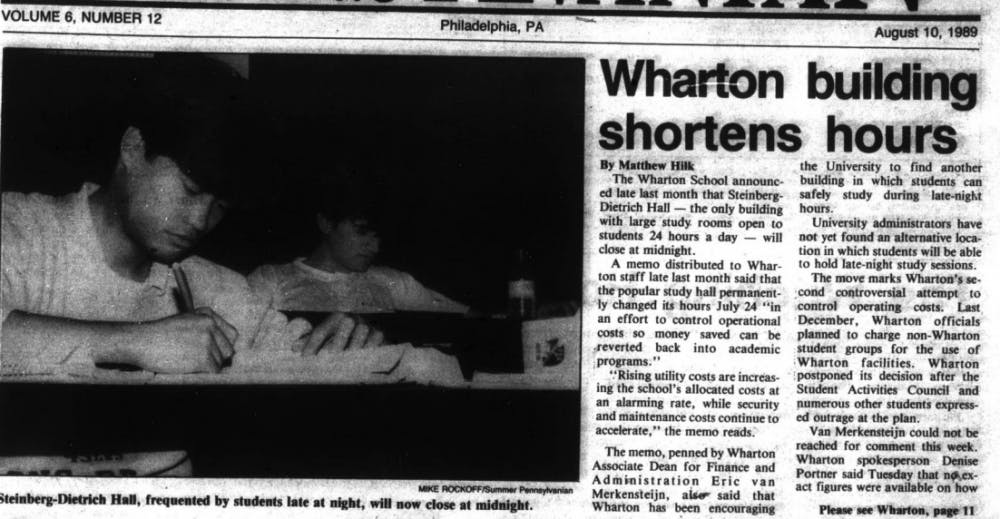
Despite initial outrage, Penn students seem to be yielding to the changes in Huntsman Hall's opening hours. Last week, a planned sit-in to protest the decision passed without making a splash, ending after just 15 minutes. Twenty-nine years ago, however, when Wharton administrators tried to limit the hours of another popular study spot, Penn students took on a stronger fighting stance.
In August 1989, when Wharton announced that Steinberg-Dietrich Hall would be closed at midnight daily instead of remaining open for 24 hours, students staged a multi-day sit-in, eventually pushing the administration to reverse its decision.
Unlike last Thursday’s protest, which attracted just eight students, the one in 1989 attracted a boisterous crowd of students and lasted for two consecutive nights, The Daily Pennsylvanian reported at the time. The protests also sparked a series of student activity, including petitions and meetings with administrators that eventually led to the re-opening of Steinberg-Dietrich Hall as an around-the-clock study hall.
At the time, the issue that had students riled up wasn’t student wellness but University finances.
“It was a budgetary challenge,” said then-Chairperson of the Undergraduate Assembly and 1990 Wharton graduate Benjamin Karsch. “[Wharton] had to figure out where to cut corners, and the decision was to close Steinberg-Dietrich at midnight.”
The early closure of the building was meant to save Wharton the annual $300,000 operational costs of keeping "Steiny-D" open at night. A memo written in July 1989 to Wharton staff noted that rising utility costs had increased the school’s allocated costs “at an alarming rate.”

1990 College graduate Kathleen Nicoll wrote an op-ed in the DP in 1989, arguing that Wharton’s decision was “a matter of confused priorities.”
"If the University considers itself an institution of learning, it should not close study halls in order to cut operation costs,” she wrote at the time. “It is tragic that this Ivy League school would even think to set such a precedent.”
Graduate students also voiced criticism, condemning the University for placing economic considerations above the academics needs of its students. The Undergraduate Assembly, which released statements acknowledging the frustrations of students, passed a resolution demanding replacement 24-hour study facilities by the first week of October.
And so on Oct. 1, two months after Wharton's initial decision, Steiny-D reopened full-time.
"We made student needs very clear, set a deadline together, and they met student needs by the deadline," Karsch, the former UA chairperson, said at the time. "This is the perfect example of the success of student representation."
Unlike in 1989, efforts to fuel student activism in response to the change in Huntsman Hall's hours have not been quite as successful. Even though more than 300 students marked "going" to the planned sit-in last week, less than 3 percent of them turned up.
Another distinction this time is the reason for the closure. Wharton administrators have said closing Huntsman Hall from 2 a.m. to 7 a.m. is part of a wider initiative to improve wellness, adding that the decision is not saving the University any significant costs.
"The idea was to really emphasize student wellness. We want students to go home at a reasonable hour and sleep," Director of Wharton Student Life Lee Kramer said. "We're hoping this is a positive step for campus and that students will be receptive to it."
The Daily Pennsylvanian is an independent, student-run newspaper. Please consider making a donation to support the coverage that shapes the University. Your generosity ensures a future of strong journalism at Penn.
Donate







